+ Open data
Open data
- Basic information
Basic information
| Entry | Database: PDB / ID: 3o8x | |||||||||
|---|---|---|---|---|---|---|---|---|---|---|
| Title | Recognition of Glycolipid Antigen by iNKT Cell TCR | |||||||||
 Components Components |
| |||||||||
 Keywords Keywords | IMMUNE SYSTEM / antigen presentation / glycolipid / NKT cells | |||||||||
| Function / homology |  Function and homology information Function and homology informationregulation of immature T cell proliferation in thymus / positive regulation of NK T cell activation / positive regulation of NK T cell differentiation / NK T cell differentiation / endogenous lipid antigen binding / antigen processing and presentation, exogenous lipid antigen via MHC class Ib / alpha-beta T cell receptor complex / positive thymic T cell selection / positive regulation of macrophage activation / Endosomal/Vacuolar pathway ...regulation of immature T cell proliferation in thymus / positive regulation of NK T cell activation / positive regulation of NK T cell differentiation / NK T cell differentiation / endogenous lipid antigen binding / antigen processing and presentation, exogenous lipid antigen via MHC class Ib / alpha-beta T cell receptor complex / positive thymic T cell selection / positive regulation of macrophage activation / Endosomal/Vacuolar pathway / DAP12 interactions / Antigen Presentation: Folding, assembly and peptide loading of class I MHC / ER-Phagosome pathway / DAP12 signaling / Immunoregulatory interactions between a Lymphoid and a non-Lymphoid cell / antigen processing and presentation / Translocation of ZAP-70 to Immunological synapse / Phosphorylation of CD3 and TCR zeta chains / positive regulation of interleukin-4 production / alpha-beta T cell activation / Generation of second messenger molecules / Co-inhibition by PD-1 / regulation of immune response / cellular defense response / T cell receptor binding / Neutrophil degranulation / positive regulation of interleukin-2 production / response to bacterium / cellular response to iron(III) ion / negative regulation of forebrain neuron differentiation / antigen processing and presentation of exogenous protein antigen via MHC class Ib, TAP-dependent / iron ion transport / peptide antigen assembly with MHC class I protein complex / regulation of iron ion transport / regulation of erythrocyte differentiation / HFE-transferrin receptor complex / response to molecule of bacterial origin / MHC class I peptide loading complex / T cell mediated cytotoxicity / positive regulation of T cell cytokine production / antigen processing and presentation of endogenous peptide antigen via MHC class I / MHC class I protein complex / positive regulation of receptor-mediated endocytosis / negative regulation of neurogenesis / cellular response to nicotine / positive regulation of T cell mediated cytotoxicity / multicellular organismal-level iron ion homeostasis / positive regulation of type II interferon production / phagocytic vesicle membrane / Immunoregulatory interactions between a Lymphoid and a non-Lymphoid cell / negative regulation of epithelial cell proliferation / sensory perception of smell / positive regulation of cellular senescence / Downstream TCR signaling / late endosome / T cell differentiation in thymus / T cell receptor signaling pathway / negative regulation of neuron projection development / protein refolding / protein homotetramerization / adaptive immune response / amyloid fibril formation / intracellular iron ion homeostasis / learning or memory / early endosome / lysosome / endosome membrane / lysosomal membrane / innate immune response / external side of plasma membrane / structural molecule activity / Golgi apparatus / protein homodimerization activity / extracellular space / plasma membrane / cytosol Similarity search - Function | |||||||||
| Biological species |   Homo sapiens (human) Homo sapiens (human) | |||||||||
| Method |  X-RAY DIFFRACTION / X-RAY DIFFRACTION /  SYNCHROTRON / SYNCHROTRON /  MOLECULAR REPLACEMENT / Resolution: 2.74 Å MOLECULAR REPLACEMENT / Resolution: 2.74 Å | |||||||||
 Authors Authors | Zajonc, D.M. / Li, Y. | |||||||||
 Citation Citation |  Journal: J.Exp.Med. / Year: 2010 Journal: J.Exp.Med. / Year: 2010Title: The V alpha 14 invariant natural killer T cell TCR forces microbial glycolipids and CD1d into a conserved binding mode. Authors: Li, Y. / Girardi, E. / Wang, J. / Yu, E.D. / Painter, G.F. / Kronenberg, M. / Zajonc, D.M. | |||||||||
| History |
|
- Structure visualization
Structure visualization
| Structure viewer | Molecule:  Molmil Molmil Jmol/JSmol Jmol/JSmol |
|---|
- Downloads & links
Downloads & links
- Download
Download
| PDBx/mmCIF format |  3o8x.cif.gz 3o8x.cif.gz | 346.2 KB | Display |  PDBx/mmCIF format PDBx/mmCIF format |
|---|---|---|---|---|
| PDB format |  pdb3o8x.ent.gz pdb3o8x.ent.gz | 280.4 KB | Display |  PDB format PDB format |
| PDBx/mmJSON format |  3o8x.json.gz 3o8x.json.gz | Tree view |  PDBx/mmJSON format PDBx/mmJSON format | |
| Others |  Other downloads Other downloads |
-Validation report
| Summary document |  3o8x_validation.pdf.gz 3o8x_validation.pdf.gz | 1.3 MB | Display |  wwPDB validaton report wwPDB validaton report |
|---|---|---|---|---|
| Full document |  3o8x_full_validation.pdf.gz 3o8x_full_validation.pdf.gz | 1.3 MB | Display | |
| Data in XML |  3o8x_validation.xml.gz 3o8x_validation.xml.gz | 31.6 KB | Display | |
| Data in CIF |  3o8x_validation.cif.gz 3o8x_validation.cif.gz | 43.9 KB | Display | |
| Arichive directory |  https://data.pdbj.org/pub/pdb/validation_reports/o8/3o8x https://data.pdbj.org/pub/pdb/validation_reports/o8/3o8x ftp://data.pdbj.org/pub/pdb/validation_reports/o8/3o8x ftp://data.pdbj.org/pub/pdb/validation_reports/o8/3o8x | HTTPS FTP |
-Related structure data
| Related structure data |  3o9wC  2q7yS  3he6S C: citing same article ( S: Starting model for refinement |
|---|---|
| Similar structure data |
- Links
Links
- Assembly
Assembly
| Deposited unit | 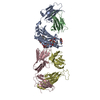
| ||||||||
|---|---|---|---|---|---|---|---|---|---|
| 1 |
| ||||||||
| Unit cell |
|
- Components
Components
-Protein , 4 types, 4 molecules ABCD
| #1: Protein | Mass: 32632.668 Da / Num. of mol.: 1 / Fragment: residues 19-297 Source method: isolated from a genetically manipulated source Source: (gene. exp.)   |
|---|---|
| #2: Protein | Mass: 11660.350 Da / Num. of mol.: 1 Source method: isolated from a genetically manipulated source Source: (gene. exp.)   |
| #3: Protein | Mass: 23055.621 Da / Num. of mol.: 1 / Mutation: T163C Source method: isolated from a genetically manipulated source Source: (gene. exp.)   Homo sapiens (human) Homo sapiens (human)Gene: TRAC, TCRA / Plasmid: pET22b / Production host:  |
| #4: Protein | Mass: 27026.998 Da / Num. of mol.: 1 / Mutation: S169C, C187S Source method: isolated from a genetically manipulated source Source: (gene. exp.)   Homo sapiens (human) Homo sapiens (human)Gene: TRBC2, TCRBC2 / Plasmid: pET30a / Production host:  |
-Sugars , 3 types, 3 molecules 
| #5: Polysaccharide | 2-acetamido-2-deoxy-beta-D-glucopyranose-(1-4)-2-acetamido-2-deoxy-beta-D-glucopyranose Source method: isolated from a genetically manipulated source |
|---|---|
| #6: Polysaccharide | 2-acetamido-2-deoxy-beta-D-glucopyranose-(1-4)-[alpha-L-fucopyranose-(1-6)]2-acetamido-2-deoxy-beta- ...2-acetamido-2-deoxy-beta-D-glucopyranose-(1-4)-[alpha-L-fucopyranose-(1-6)]2-acetamido-2-deoxy-beta-D-glucopyranose Source method: isolated from a genetically manipulated source |
| #8: Sugar | ChemComp-NAG / |
-Non-polymers , 2 types, 108 molecules 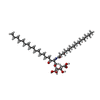


| #7: Chemical | ChemComp-GSL / ( |
|---|---|
| #9: Water | ChemComp-HOH / |
-Details
| Has protein modification | Y |
|---|
-Experimental details
-Experiment
| Experiment | Method:  X-RAY DIFFRACTION / Number of used crystals: 1 X-RAY DIFFRACTION / Number of used crystals: 1 |
|---|
- Sample preparation
Sample preparation
| Crystal | Density Matthews: 3.02 Å3/Da / Density % sol: 59.34 % |
|---|---|
| Crystal grow | Temperature: 295 K / Method: vapor diffusion, sitting drop / pH: 7.4 Details: 18% polyethylene glycol 3350, 0.2 M ammonium citrate dibasic, pH 7.4, VAPOR DIFFUSION, SITTING DROP, temperature 295K |
-Data collection
| Diffraction | Mean temperature: 100 K |
|---|---|
| Diffraction source | Source:  SYNCHROTRON / Site: SYNCHROTRON / Site:  SSRL SSRL  / Beamline: BL7-1 / Wavelength: 0.97946 Å / Beamline: BL7-1 / Wavelength: 0.97946 Å |
| Detector | Type: ADSC QUANTUM 315r / Detector: CCD / Date: Feb 16, 2010 / Details: Rh coated flat mirror; single crystal |
| Radiation | Monochromator: side scattering I-beam bent single crystal; asymmetric cut 4.9650 deg Protocol: SINGLE WAVELENGTH / Monochromatic (M) / Laue (L): M / Scattering type: x-ray |
| Radiation wavelength | Wavelength: 0.97946 Å / Relative weight: 1 |
| Reflection | Resolution: 2.74→50 Å / Num. all: 30526 / Num. obs: 29275 / % possible obs: 95.9 % / Observed criterion σ(F): 0 / Observed criterion σ(I): 0 / Redundancy: 5.6 % / Biso Wilson estimate: 58.58 Å2 / Rmerge(I) obs: 0.05 / Net I/σ(I): 15.3 |
| Reflection shell | Resolution: 2.74→2.84 Å / Redundancy: 5.5 % / Rmerge(I) obs: 0.464 / Mean I/σ(I) obs: 2.68 / Num. unique all: 2921 / % possible all: 97.5 |
- Processing
Processing
| Software |
| ||||||||||||||||||||||||||||||||||||||||||||||||||||||||||||||||||||||||||||||||||||||||||||||||||||||||||||||||||||||||||||||||||||||||||||||||||||||
|---|---|---|---|---|---|---|---|---|---|---|---|---|---|---|---|---|---|---|---|---|---|---|---|---|---|---|---|---|---|---|---|---|---|---|---|---|---|---|---|---|---|---|---|---|---|---|---|---|---|---|---|---|---|---|---|---|---|---|---|---|---|---|---|---|---|---|---|---|---|---|---|---|---|---|---|---|---|---|---|---|---|---|---|---|---|---|---|---|---|---|---|---|---|---|---|---|---|---|---|---|---|---|---|---|---|---|---|---|---|---|---|---|---|---|---|---|---|---|---|---|---|---|---|---|---|---|---|---|---|---|---|---|---|---|---|---|---|---|---|---|---|---|---|---|---|---|---|---|---|---|---|
| Refinement | Method to determine structure:  MOLECULAR REPLACEMENT MOLECULAR REPLACEMENTStarting model: 2Q7Y, 3HE6 Resolution: 2.74→41.47 Å / Cor.coef. Fo:Fc: 0.931 / Cor.coef. Fo:Fc free: 0.887 / SU B: 25.789 / SU ML: 0.239 / Cross valid method: THROUGHOUT / σ(F): 0 / σ(I): 0 / ESU R: 1.217 / ESU R Free: 0.348 / Stereochemistry target values: MAXIMUM LIKELIHOOD / Details: HYDROGENS HAVE BEEN ADDED IN THE RIDING POSITIONS
| ||||||||||||||||||||||||||||||||||||||||||||||||||||||||||||||||||||||||||||||||||||||||||||||||||||||||||||||||||||||||||||||||||||||||||||||||||||||
| Solvent computation | Ion probe radii: 0.8 Å / Shrinkage radii: 0.8 Å / VDW probe radii: 1.4 Å / Solvent model: MASK | ||||||||||||||||||||||||||||||||||||||||||||||||||||||||||||||||||||||||||||||||||||||||||||||||||||||||||||||||||||||||||||||||||||||||||||||||||||||
| Displacement parameters | Biso mean: 41.065 Å2
| ||||||||||||||||||||||||||||||||||||||||||||||||||||||||||||||||||||||||||||||||||||||||||||||||||||||||||||||||||||||||||||||||||||||||||||||||||||||
| Refinement step | Cycle: LAST / Resolution: 2.74→41.47 Å
| ||||||||||||||||||||||||||||||||||||||||||||||||||||||||||||||||||||||||||||||||||||||||||||||||||||||||||||||||||||||||||||||||||||||||||||||||||||||
| Refine LS restraints |
| ||||||||||||||||||||||||||||||||||||||||||||||||||||||||||||||||||||||||||||||||||||||||||||||||||||||||||||||||||||||||||||||||||||||||||||||||||||||
| LS refinement shell | Resolution: 2.738→2.808 Å / Total num. of bins used: 20
| ||||||||||||||||||||||||||||||||||||||||||||||||||||||||||||||||||||||||||||||||||||||||||||||||||||||||||||||||||||||||||||||||||||||||||||||||||||||
| Refinement TLS params. | Method: refined / Refine-ID: X-RAY DIFFRACTION
| ||||||||||||||||||||||||||||||||||||||||||||||||||||||||||||||||||||||||||||||||||||||||||||||||||||||||||||||||||||||||||||||||||||||||||||||||||||||
| Refinement TLS group |
|
 Movie
Movie Controller
Controller





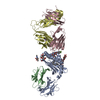
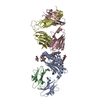
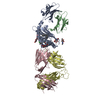
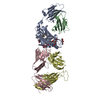
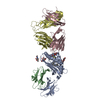
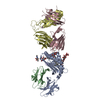
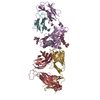
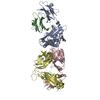
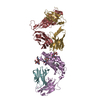
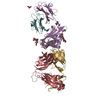
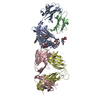
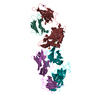
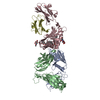
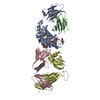
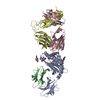
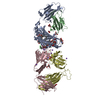
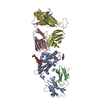
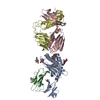
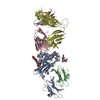
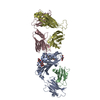
 PDBj
PDBj
















